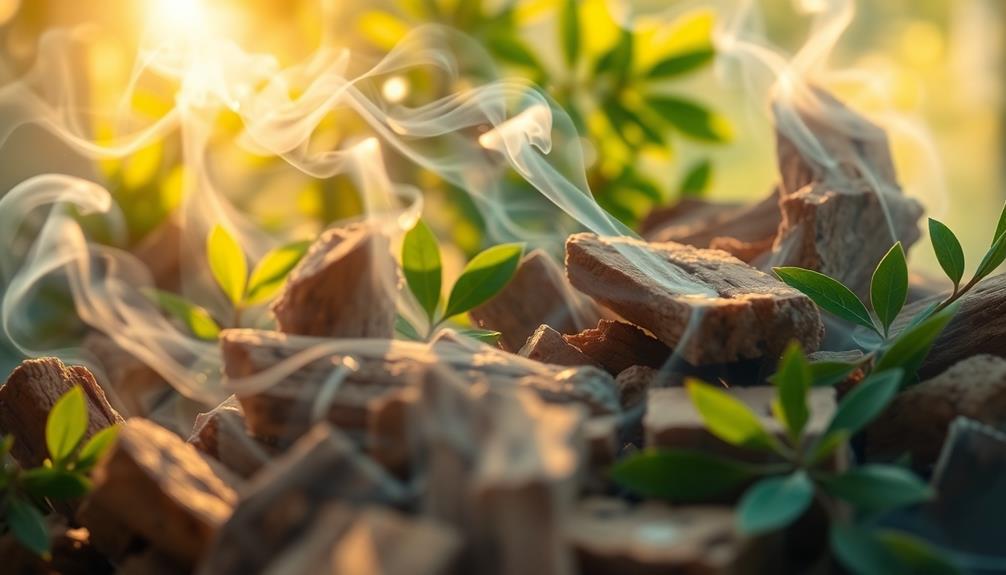Turmeric has a warm, earthy smell that's truly unique. When you use fresh turmeric, you'll notice a vibrant and sharp aroma, while dried turmeric has a milder scent. The smell combines hints of ginger and a bit of orange, creating a complex fragrance that's both pungent and slightly bitter. When you cook with turmeric, it really comes alive, filling your kitchen with an inviting, rich scent. This amazing aroma often reminds people of family gatherings and traditional recipes. If you're curious about how to incorporate turmeric into your cooking, there's a lot more to discover!
Key Takeaways
- Turmeric has a mildly aromatic scent characterized by earthy and warm notes, often described as pungent and slightly bitter.
- Fresh turmeric emits a vibrant and sharp fragrance, while dried turmeric has a more subdued aroma.
- The aroma combines earthy notes reminiscent of ginger with a hint of orange, creating a captivating scent.
- Cooking with turmeric enhances its aroma, filling kitchens with a warm and inviting atmosphere.
- Overusing turmeric can overpower other delicate flavors, so moderation in its use is essential.
Introduction
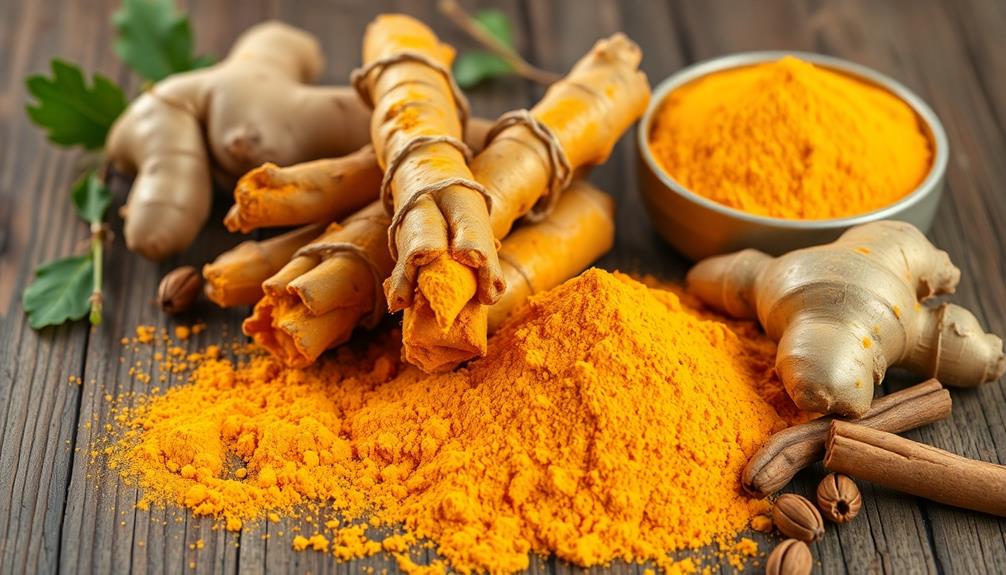
When you think about turmeric, its aroma is likely one of the first things that comes to mind. This spice has a mildly aromatic scent that mixes earthy and warm notes, reminding you of ginger and mustard.
You might notice that ground turmeric has a more subdued fragrance compared to fresh turmeric. Fresh turmeric gives off a vibrant and sharp scent, while the dried version can be a bit less intense.
The unique scent of turmeric is often described as pungent and slightly bitter. It's this distinctive aroma that makes turmeric a popular ingredient in many dishes around the world.
When you cook with turmeric, the aroma can become even more pronounced, enhancing the overall sensory experience of your meal. This means that the smell of turmeric can really boost the flavors in your cooking.
Description of the Smell
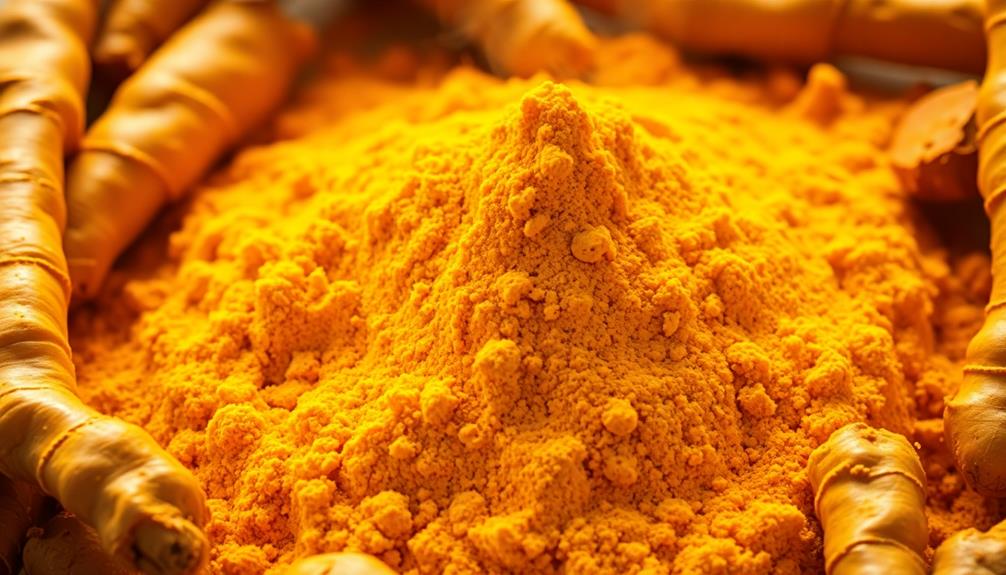
Turmeric's smell can be captivating and complex, often evoking a sense of warmth and earthiness. When you encounter turmeric, you might notice its mildly aromatic scent, which combines earthy notes reminiscent of ginger with a hint of orange. This unique aroma can be pungent and slightly bitter, making it a wonderful addition to various dishes.
Imagine cooking a savory meal with melted butter, where the rich, buttery scent mingles with turmeric, creating an inviting atmosphere.
When fresh, turmeric gives off a vibrant fragrance that can brighten up any kitchen. However, if you use dried turmeric, you might find that some of its aromatic qualities have faded over time. The smell of turmeric can enhance your favorite recipes, but be cautious! Using too much can overpower more delicate flavors, so it's best to start with a little and adjust as needed.
This characteristic aroma is one reason turmeric is a key ingredient in many spice blends and curry powders, contributing to the distinctive smells of these cuisines.
Next time you use turmeric, take a moment to appreciate its warm, earthy scent—it truly adds depth to your culinary creations.
Source and Composition
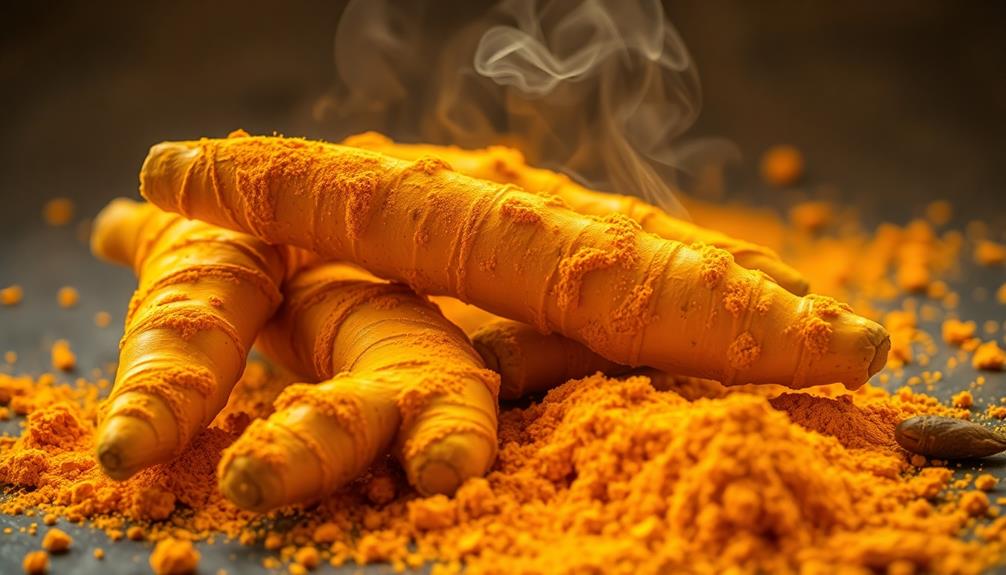
The vibrant orange-yellow hue of turmeric root hints at its rich source of aromatic compounds. When you take a whiff, you'll notice that turmeric has a mildly aromatic scent. It's earthy, warm, and slightly peppery, reminding you of both ginger and mustard.
The distinct aroma comes mainly from essential oils, especially turmerones, which play a big role in its fragrance profile. You might find that fresh turmeric root has a more pronounced and lively scent compared to dried turmeric powder.
As turmeric ages, it can lose some of its aromatic qualities. So, if you want that vibrant smell, fresh roots are the way to go! When you cook with turmeric, the aroma becomes even more intense and complex, adding a delightful touch to your dishes.
For the best experience, try using fresh turmeric. Not only will it enhance your meal, but it'll also fill your kitchen with an inviting scent.
Next time you're in the spice aisle, remember that the source and composition of turmeric are what give it that unique smell that can brighten up any recipe!
Typical Scenarios or Environments

In bustling kitchens across India and Southeast Asia, the scent of turmeric fills the air as it's skillfully blended into curries and rice dishes. You might notice that turmeric has a distinctly earthy aroma, with hints of orange and ginger. When it's cooked, the smell gets even stronger, making your mouth water and drawing everyone to the kitchen.
Picture yourself grating fresh turmeric; you'll release a pungent, slightly bitter fragrance that fills the space. This scent is often mixed with spices, creating a warm and inviting atmosphere.
You might also find turmeric being used in traditional recipes, like turmeric tea or golden milk, where its comforting smell can be quite soothing.
But turmeric isn't just for cooking! Many people use it to dye fabrics, giving a beautiful golden color that brightens up any material.
Emotional or Cultural Associations

Aromatic spices like turmeric often stir up deep emotional connections and cultural significance, especially in many Asian households. The warm, earthy scent of turmeric can remind you of family gatherings and traditional cooking. It's that bright orange spice you smell in delicious Indian dishes and cooked vegetables, bringing comfort and nostalgia.
In Indian culture, turmeric isn't just a spice; it symbolizes purity and prosperity. You might find it at weddings and religious ceremonies, where its scent adds to the joyful atmosphere. Its aroma also links to health benefits, as turmeric is widely used in Ayurvedic practices, promoting a sense of wellness and healing.
As you cook with turmeric, you might feel a connection to your heritage, recalling family recipes passed down through generations. This spice brings people together, making every gathering feel warm and inviting.
When you take a whiff of turmeric, you're not just smelling a spice; you're experiencing a rich tapestry of memories and traditions that bind families and communities. So, the next time you use turmeric, embrace the emotions and cultural significance it carries—it's more than just a cooking ingredient!
Health or Safety Considerations
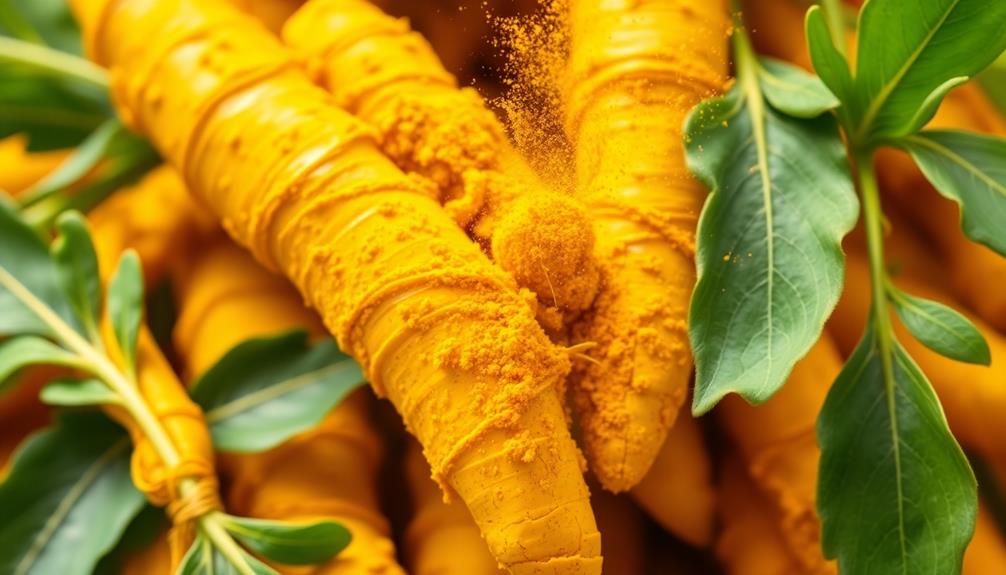
Turmeric's rich cultural significance and comforting aroma can sometimes overshadow important health and safety considerations. While turmeric has a mild, earthy smell with hints of orange and ginger, using too much can make its scent pungent and overpowering.
Additionally, turmeric's potent relief for osteoarthritis pain makes it a popular choice for many seeking natural remedies, but it's essential to enjoy it in moderation. Some people might be allergic to turmeric, so if you have sensitivities, be cautious.
Turmeric is also known to act as a natural blood thinner, which can be risky for anyone taking anticoagulant medications or those with bleeding disorders. Always check with your doctor before adding turmeric to your diet in larger amounts.
Additionally, the curcumin in turmeric can interact with certain medications, making it vital to consult healthcare professionals before significant consumption. If you're buying products that contain turmeric, look for clear labeling. This helps inform you about potential allergens and health risks.
Final Thoughts
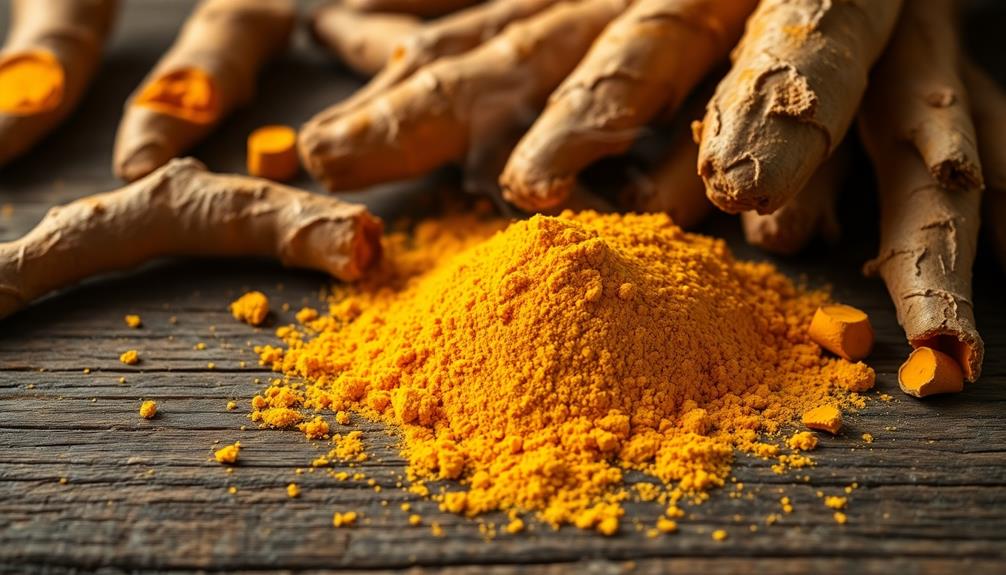
The unique scent of turmeric adds depth to countless dishes, making it a beloved ingredient in kitchens around the world. When you use turmeric, you'll notice its mildly aromatic scent with hints of orange and ginger.
This earthy and slightly pungent aroma can really enhance the flavors of your meals. However, it's important to remember that turmeric's smell can be pretty strong, so always use it in moderation. You don't want it to overpower the more delicate flavors in your recipes!
When cooked, the aroma of turmeric becomes even more pronounced, releasing warm and slightly bitter notes that pair well with various savory dishes.
If you have fresh turmeric, you'll find its smell is more vibrant and intense compared to dried turmeric powder, which often loses some aroma over time.
Frequently Asked Questions
How Do You Describe the Smell of Turmeric?
When you describe turmeric's smell, you'll notice its earthy, warm aroma with pungent, slightly bitter undertones. Fresh turmeric brings a zesty fragrance, while ground turmeric offers a concentrated, astringent scent that can dominate dishes.
Does Turmeric Smell Like Mustard?
You might find that turmeric does smell somewhat like mustard, sharing earthy and pungent notes. However, its aroma is more complex and aromatic, especially when cooked, enhancing dishes with a warm, inviting fragrance. The scent of turmeric can also have subtle hints of ginger or orange, adding a slight sweetness to its otherwise robust profile. Interestingly, while its smell is often inviting, its depth and earthiness can sometimes evoke comparisons to less pleasant aromas, such as a dog ear infection odor — though this is rare and more likely in particularly strong, concentrated forms of turmeric. Despite this, the spice remains a beloved staple in many global cuisines, offering both flavor and aroma that are hard to replicate.
Does Turmeric Smell Like Curry?
You might think turmeric smells like curry, but it doesn't. Turmeric has an earthy aroma, while curry's scent comes from a mix of spices, including turmeric, creating a more complex and fragrant profile.
Does Turmeric Turn Pee Yellow?
Yes, turmeric can turn your urine bright yellow due to curcumin, a natural pigment. This harmless change usually fades within a few hours, depending on how much turmeric you've consumed and your hydration levels.

